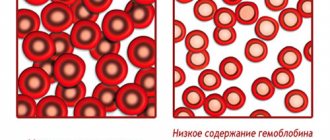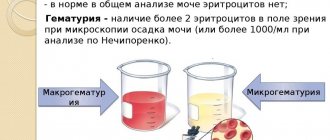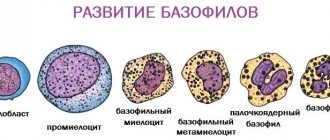What does the analysis say?
To determine ESR, venous or capillary blood is taken from a child. This indicator helps to identify the disease at an early stage, when symptoms are not yet pronounced or absent.
It will not be possible to determine what kind of pathology is developing in a small patient based on the ESR. For this purpose, you will have to undergo an examination and take additional tests.
Deviations in ESR do not require special therapy. This indicator returns to normal as soon as the underlying disease is identified and eliminated.
Why are the rates increasing and what diseases does this indicate?
An ESR value in a child’s blood exceeding 20 mm/hour (25, 30, 40 and above) indicates the development of a pathological process. Moreover, a value of 40 mm/hour is a sign of a serious illness that will require long-term treatment. An increased ESR in a child is more common than a decreased one. The indicator increases with the following diseases:
- pathologies of the liver, kidneys;
- large blood loss;
- hemoblastosis;
- leukemia;
- anemia;
- allergy;
- hyperthyroidism;
- hypothyroidism;
- diabetes;
- autoimmune diseases;
- connective tissue diseases;
- sepsis;
- cancer;
- tuberculosis;
- heart attack;
- infectious diseases;
- inflammation.
Deviation of the results from the norm indicates a pathological process, which one is determined by the attending physician.
To clarify the diagnosis, you will need to pay attention to other indicators, including the level of platelets and leukocytes. With oncology, anemia, rheumatic diseases or systematic overexertion, platelets will be increased. If platelets are low, this indicates a viral infection (eg, acute respiratory viral infection), hemophilia, or is the result of taking certain medications (see also: causes of low platelets in a newborn).
A low level of leukocytes indicates systemic diseases of the immune system, viral infection, seasonal hypovitaminosis. Low white blood cells are often observed in residents of regions with increased radiation activity. An increased level of leukocytes accompanies bronchitis, pleurisy, sinusitis, appendicitis (see also: how to recognize appendicitis in a child by the first signs?).
ESR: norm for children by age - table
The acceptable parameters of this indicator are individual for each child. They depend on age and gender. The emotional and physical state of the baby before the test is also important.
The slightest physiological change in the body will have an impact on the result. In this regard, the scope of determining the ESR norm is quite extensive.
| Age | ESR in blood, mm/hour |
| Newborn | 1,0-2,7 |
| 5-9 days | 2,0-4,0 |
| 9-14 days | 4,0-9,0 |
| 30 days | 3-6 |
| 2-6 months | 5-8 |
| 7-12 months | 4-10 |
| 1-2 years | 5-9 |
| 2-5 years | 5-12 |
| 3-8 | 6-11 |
| 9-12 | 3-10 |
| 13-15 | 7-12 |
| 16-18 | 7-14 |
Minor deviations from the specified values are not a cause for concern. Pediatricians pay attention to this indicator if it is significantly higher or lower than normal.
An increase of more than 20 units indicates a dangerous pathological process in the baby’s body. This situation requires prompt medical examination, identification and elimination of the root cause.
Due to the imperfection of metabolic processes in the body of newborns, their ESR indicators are minimal. As you get older, this figure also increases. The normal ESR level in the blood of older children has wider boundaries.
An excess of 40 units indicates a severe disorder in the body. This indicator requires immediate diagnosis and treatment of the disease.
The role of ESR in the child’s body
What does ESR mean in a child’s blood? Red blood cells, which are 90% hemoglobin, are heavier than plasma, so their important characteristic is their sedimentation rate. By how quickly red blood cells precipitate, one can judge the inflammatory processes in the child’s body.
Why does ESR increase? During inflammation, red cells begin to stick together with each other, so their mass increases, and accordingly, the sedimentation rate increases. If the ESR indicators are normal, it means that there are no disturbances in the functioning of the circulatory system.
When making a diagnosis, doctors also pay attention to other elements of the clinical analysis, for example, white blood cells.
Using ESR in children, the following pathologies can be identified:
- inflammatory processes;
- infectious diseases;
- appendicitis;
- diseases of the cardiovascular system;
- diseases of the hematopoietic organs;
- disruption of the immune system;
- malignant formations.
If, according to the results of the analysis, the ESR indicator does not correspond to the norm, then an additional examination is prescribed.
ESR is higher than normal
An increase in indicators does not always indicate a serious illness. Among the reasons leading to exceeding ESR standards are the following:
- avitaminosis;
- active phase of teething;
- eating disorder;
- taking certain medications, in particular paracetamol;
- helminthic infestation;
- stress, excited state of the nervous system.
Exceeding by several values is not critical. But this is provided that nothing bothers the child.
If the values are much higher than the specified norms, then this indicates a disease. To identify it, the doctor prescribes additional examinations: ultrasound diagnostics, biochemical blood tests, and urine tests.
Here are several diseases that cause an increase in ESR values:
- pathologies of an infectious nature;
- allergic reactions;
- oncology;
- diabetes;
- anemia;
- hormonal disorders;
- violation of the integrity of the skin (injuries, burns).
The ESR level in the blood of children can increase for many reasons. This analysis is, in a sense, a litmus test. He gives the green light for additional research if the doctor deems it necessary.
WESTERGREN ESR - what does it mean?
The erythrocyte sedimentation/binding rate is an indicator of a nonspecific type that characterizes the speed of interaction of erythrocytes and their connection with each other.
It is important to understand that the ESR level alone does not give a complete picture of the health of the child’s body. We can talk about pathologies and deviations only in two cases:
- the ESR level differs significantly from the norm for at least 10 days;
- Along with fluctuations, there is a deviation from the norm in other indicators (for example, the content of leukocytes, platelets, etc.).
blood test to determine elevated ESR levels
In order to assess the rate of red blood cell binding, it is enough to take a blood test (general). It is performed in the morning, no later than 3-4 hours after waking up. Before performing it, you must exclude any food (a small amount of clean water is allowed).
To obtain a reliable result, you should not rub your fingertips before submitting the material for analysis. Many parents believe that such manipulations will reduce the sensitivity of children's fingers. This is wrong. These actions will not relieve pain, but they may well influence the result of the analysis.
It is recommended to take a general blood test:
- at least once a year if the child is healthy;
- at least once every six months if the child often suffers from colds and infectious diseases;
- at least 2 times a year - for children under 3 years of age;
- before each preventive vaccination (according to the vaccination calendar).
If, according to the results of the Westergren ESR analysis, the ESR is elevated, the vaccine cannot be given. You should retake the analysis and see what the results turned out to be. If the level again exceeds the permissible values, the child needs mandatory examination, since there is a high probability of developing an inflammatory process.
In some cases, the doctor may refer the baby for testing within a few days. This is necessary in cases where the child appears healthy, but the erythrocyte sedimentation rate according to the results of 2-3 studies remains high. If the ESR is elevated for 10 days in a row, there may be hidden pockets of inflammation in the body.
Reduced values
This option is less common than exceeding values. But, identical to elevated indicators, this result cannot be decisive in making a diagnosis. It only indirectly indicates disorders and malfunctions in the body.
Possible health problems may include:
- heart disease;
- poor blood circulation;
- hemophilia;
- liver pathologies;
- change in acid-base balance;
- autoimmune diseases;
- exhaustion and dehydration of the body.
What exactly caused the decrease in erythrocyte sedimentation rate can only be determined by a general examination. Without additional laboratory and hardware tests, it is not possible to establish the exact cause.
Why does ESR increase in children?
The reasons for the increase in the indicator are different, so only a doctor can prescribe treatment.
When collecting a medical history of a small patient, data from laboratory and instrumental research methods, as well as the presence and severity of symptoms of the disease are taken into account. As necessary, the most complete family history of the child is collected, taking into account genetic predisposition to hereditary pathologies.
It should be understood that a slight deviation from the norm has no diagnostic significance. So, if a one-year-old child has an ESR of 11 mm/h, then this is considered acceptable and may indicate a recent infection (the test must be repeated after 2 weeks).
The most common cause of increased ESR is an infectious disease, predominantly of a bacterial nature.
Inflammatory processes of various localizations, burns of varying degrees and mechanical injuries are also among the reasons for deviation of the criterion from the norm.
Also, the level of erythrocyte sedimentation rate may increase if the patient has malignant diseases. A significant excess of the norm is observed in the following oncopathologies:
- multiple myeloma (Rustitsky-Kale disease), localized in the bone marrow. In this case, the value of the criterion reaches critical values. The disease is characterized by excessive production of pathological proteins, leading to the formation of “coin columns” - multiple aggregation of red blood cells;
- Lymphogranulomatosis (Hodgkin's disease) affects people regardless of gender and age. This pathology affects lymphoid tissues. The ESR level is of primary importance not for identifying pathology, but for determining its course and assessing the effectiveness of selected therapeutic methods.
Other malignant neoplasms are also accompanied by an upward deviation from the norm. There is a direct correlation (dependence) between the degree of criterion deviation and the stage of cancer. Thus, the highest ESR values are characteristic of the terminal stage and the spread of metastases to neighboring organs and tissues.
False positive result
Yes, this also happens. This result cannot be considered reliable. There are a number of reasons why the ESR is higher than normal in a child.
Among them:
- poor kidney function;
- excess weight;
- recent vaccination against hepatitis B;
- vitamin A intake;
- hypercholesterolemia.
Also important is the influence of technical violations that occurred during the diagnostic process.
Increased ESR - reasons
An increase in the rate of erythrocyte binding is observed in various inflammatory processes resulting from infectious diseases.
The most common reasons for an increase in erythrocyte sedimentation rate are the following:
- tuberculosis;
- measles, rubella;
- sore throat and other bacterial respiratory tract infections;
- anemia (anemia);
- allergic reaction upon contact with irritants/allergens;
- damage to bone and joint tissue (trauma, fractures);
- hemoblastosis;
- whooping cough;
- endocrine pathologies.
False-positive ESR test
In some cases, an increase in the rate of interaction of red blood cells has nothing to do with infections and pathologies in the functioning of internal organs.
An elevated ESR level may be caused by the following reasons:
- deficiency of vitamins and nutrients (especially in autumn and spring);
- parasitic infestation (worms);
- improper diet (the menu contains plenty of fatty foods, as well as spicy and smoked dishes);
- taking Paracetamol and other drugs based on it;
- teething in infants (especially first teeth and canines);
- a stressful state immediately before donating blood (for example, when a child is very afraid to donate blood).
Symptoms
Often, when the erythrocyte sedimentation rate changes, the child does not worry about anything. And the pathology itself is detected only during a routine examination. But it happens that the disease, against the background of changes in indicators, gives characteristic symptoms.
- Diabetes mellitus provokes increased thirst and, as a result, frequent urination. Body weight decreases and there is a risk of developing skin infections. With this pathology, thrush can often be observed.
- During cancer processes, the baby rapidly loses weight. Immunity decreases, weakness and fatigue appear. This dangerous condition is also indicated by enlarged lymph nodes.
- Infectious and viral diseases provoke a rise in body temperature and headache. They will be indicated by shortness of breath, palpitations, as well as symptoms of general intoxication of the body.
- Tuberculosis is characterized by cough and chest pain. Weight loss, malaise and frequent headaches are symptoms of this disease.
If the child has changes in ESR levels, but there are no symptoms of the disease, and additional examination did not reveal any abnormalities, everything is fine. Perhaps this is simply a physiological feature of the baby’s body.
What to do
If the erythrocyte sedimentation rate in the child’s circulatory system is outside the normal range, but its fluctuations are insignificant, and the child does not complain about the state of his health, then nothing significant is observed in him and he is not sick with anything. But just to be sure, you can ask your doctor for a referral for additional blood tests to make sure that your child is absolutely healthy.
If the ESR is between 40-50 mm/h, then the doctor will diagnose a serious disease, the treatment of which will take quite a long time and you need to be prepared for this.
It should be remembered that increased or decreased blood ESR does not require treatment, but it is necessary to identify the cause or disease that caused this anomaly. In the future, the erythrocyte sedimentation rate will return to its normal state, but this will happen after recovery and will take more than one month.
Features of normalization of indicators
By itself, increased or decreased erythrocyte sedimentation rate is not treated. To normalize the values, it is necessary to correctly diagnose the disease that caused the failure. After therapeutic measures aimed at getting rid of the pathology, the norm of ESR in the blood of children stabilizes.
But some diseases may have their own nuances that affect the indicators. For example, after an infectious disease, the values return to normal after 1-2 months. Sometimes even a significant excess of the permissible values does not indicate illness. This may be due to the physiological characteristics of the body.
The indicators are also influenced by the characteristics of testing tests at a particular medical center. Each medical institution has its own laboratory research methods, so the results may be different. This is especially true for the analysis of erythrocyte sedimentation rate, the value of which is influenced by many reasons.
When do the indicators return to normal?
You need to start by finding out the reason for the deviation from the norm. It is important to pay attention to the concentration of other indicators. If there are diseases of the internal organs, an instrumental examination will be required.
As a rule, after treatment of the underlying disease, the ESR returns to normal on its own. But this happens very slowly, over the course of a month. That is why you should donate blood again some time after recovery.
The rate at which ESR returns to normal largely depends on the magnitude of its deviation. If the increase or decrease was only a few units, up to 10 mm/h, then recovery occurs in 2-3 weeks. In case of severe illnesses, when the ESR in children exceeds the norm by more than 2-3 times, the indicator reaches normal values within several months.
Reasons for the low level
Indicators below normal are less common than elevated ones. If an increase is most often the result of the influence of external factors that are not related to the child’s health, then a decreased level is almost always evidence of disturbances in the functioning of the body.
Important information: How to quickly increase the level of platelets in the blood (which foods increase it)
If the ESR is low, then most often this means that there are disturbances in the functioning of the circulatory system. At the same time, the number of red blood cells in the blood is normal or may even increase slightly, but the interaction between them remains weak. If the analysis shows a value below normal, this may indicate poor coagulation or severe blood thinning, or impaired blood flow.
A low ESR in a child’s blood may indicate dehydration caused by diarrhea, vomiting, the development of hepatitis, or poisoning. In children in the first months of life, dehydration can occur as a result of a lack of water in the baby's diet. Decreased results indicate an unbalanced diet and a deficiency of protein in the body.
There are often cases when, against the background of hereditary pathologies, ESR in a blood test shows reduced values. To confirm, it will be necessary to analyze other data that a detailed blood test showed.
False positive result
Often you have to deal with the fact that the analysis results in not entirely accurate data. Doctors in such a situation declare a false positive result. The data that such a test shows cannot be considered correct. They cannot be evidence that a disease is developing in the body.
A false positive result may occur due to:
- Anemia, without morphological changes.
- Increased concentration of protein compounds in plasma. The only exception is fibrinogen.
- Insufficient kidney function.
- Hypercholesterolemia.
- Excess weight.
- Taking vitamin A.
- Vaccinations against hepatitis.
In adult women, false positive test results may occur during pregnancy.
If a child has an elevated ESR, but at the same time he feels normal, does not complain about anything and does not have any symptoms of the disease, the doctor may refer him for additional tests:
- X-rays of light.
- ECG.
- Examination of the condition of the tonsils, lymph nodes, heart, spleen, kidneys.
- Blood tests to determine the presence of total protein, immunoglobulins, platelet and reticulocyte counts.
ESR in combination with other blood indicators allows us to draw a conclusion about the child’s health status. If, as a result of a complete examination, it was not possible to identify the reasons for the increase in ESR, a conclusion is drawn about the individual characteristics of the body. In some cases, ESR may be elevated, but all other blood parameters remain within normal limits. In this situation, repeated tests are carried out after some time to make sure that everything is fine with the child.
Important information: Why are lymphocytes in the blood low during pregnancy?
Incorrect test results may be the result of technical violations committed during diagnostics: non-compliance with the temperature regime or insufficient exposure of the biomaterial, lack of anticoagulants used during the test.
What to do in case of deviations
When test results show deviations from the norm, this is always a reason for concern. In the case of erythrocyte sedimentation rate, it is necessary to first assess how much the indicators differ from the norm.
If the ESR is 15 or lower, we can talk about a false positive result, which was provoked by external factors. In this situation, a repeat test may be recommended. If the results remain unchanged and there are no complaints of malaise, no additional actions need to be taken.
An indicator of 20 CJ indicates an inflammatory process. An ESR in children over 30 mm/h indicates severe pathologies; heart pathologies or chronic infectious diseases are possible.
It is impossible to draw any conclusions based on the ESR level, since this is an unstable indicator. To confirm or refute the diagnosis, it is recommended to undergo additional studies.
There is no special treatment for deviations. ESR is only an indicator that allows you to judge the condition of internal organs. Therapy is prescribed only after determining the cause of the deviations and clarifying the diagnosis. After eliminating the main cause of the change, the ESR quickly returns to normal.











